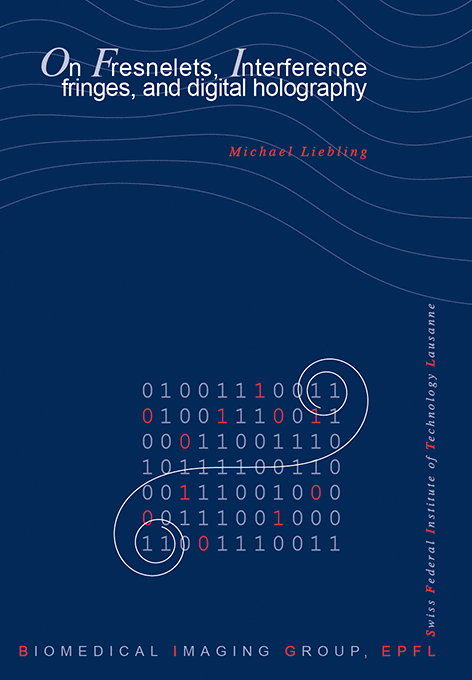On Fresnelets, Interference Fringes, and Digital Holography
M. Liebling
SSBE research award, École polytechnique fédérale de Lausanne, EPFL Thesis no. 2977 (2004), 151 p., April 21, 2004.
2004 Research Award of the Swiss Society for Biomedical Engineering
In this thesis, we describe newapproaches and methods for reconstructing complex-valued wave fields from digital holograms. We focus on Fresnel holograms recorded in an off-axis geometry, for which operational real-time acquisition setups readily exist.
The three main research directions presented are the following. First, we derive the necessary tools to port methods and concepts of wavelet-based approaches to the field of digital holography. This is motivated by the flexibility, the robustness, and the unifying view that such multiresolution procedures have brought to many applications in image processing. In particular, we put emphasis on space-frequency processing and sparse signal representations. Second, we propose to decouple the demodulation from the propagation problem, which are both inherent to digital Fresnel holography. To this end, we derive a method for retrieving the amplitude and phase of the object wave through a local analysis of the hologram's interference fringes. Third, since digital holography reconstruction algorithms involve a number of parametric models, we propose automatic adjustment methods of the corresponding parameters.
We start by investigating the Fresnel transform, which plays a central role in both the modeling of the acquisition procedure and the reconstruction of complex wave fields. The study of the properties that are central to wavelet and multiresolution analysis leads us to derive Fresnelets, a new family of waveletlike bases. Fresnelets permit the analysis of holograms with a good localization in space and frequency, in a way similar to wavelets for images. Since the relevant information in a Fresnel off-axis hologram may be separated both in space and frequency, we propose an approach for selectively retrieving the information in the Fresnelet domain. We show that in certain situations, this approach is superior to others that exclusively rely on the separation in space or frequency.
We then derive a least-squares method for the estimation of the object wave's amplitude and phase. The approach, which is reminiscent of phase-shifting techniques, is sufficiently general to be applied in a wide variety of situations, including those dictated by the use of microscopy objectives.
Since it is difficult to determine the reconstruction distance manually, we propose an automatic procedure. We take advantage of our separate treatment of the phase retrieval and propagation problems to come up with an algorithm that maximizes a sharpness metric related to the sparsity of the signal's expansion in distance-dependent Fresnelet bases.
Based on a simulation study, we suggest a number of guidelines for deciding which algorithm to apply to a given problem. We compare existing and the newly proposed solutions in a wide variety of situations. Our final conclusion is that the proposed methods result in flexible algorithms that are competitive with preexisting ones and superior to them in many cases. Overall, they may be applied in a wide range of experimental situations at a low computational cost.

@PHDTHESIS(http://bigwww.epfl.ch/publications/liebling0402.html,
AUTHOR="Liebling, M.",
TITLE="On {F}resnelets, Interference Fringes, and Digital Holography",
SCHOOL="{\'{E}}cole polytechnique f{\'{e}}d{\'{e}}rale de {L}ausanne
({EPFL})",
YEAR="2004",
type="{EPFL} Thesis no.\ 2977 (2004), 151 p.",
address="",
month="April 21,",
note="{SSBE} research award")